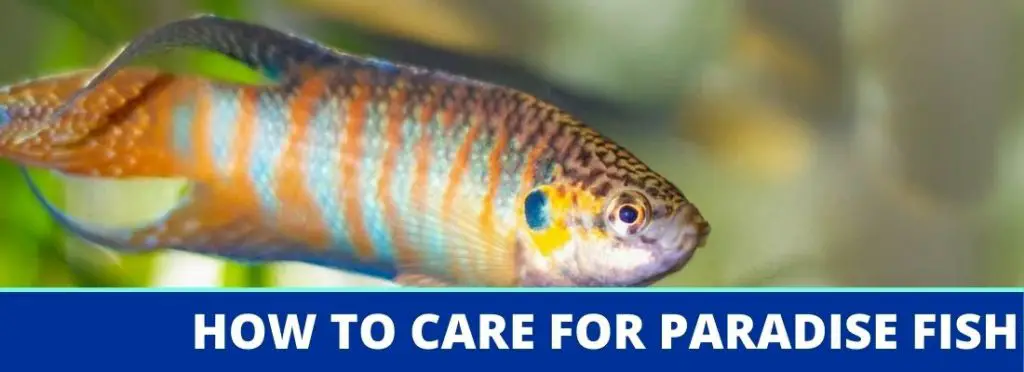The paradise fish is a gorgeous, unique-looking tropical freshwater fish that’s gained popularity in the fishkeeping world. Many aquarists love them for their aesthetics, as well as their unique personalities and the care level (easy) that allows even beginner hobbyists to care for and keep them well.
These fish are pretty hardy, meaning they really can endure a lot, but they’re semi-aggressive so their tankmates need to be carefully considered before they are brought home.
If you’re interested in these beautiful fish, you’ll need to consider a few specific things, so let’s take a look.
Quick Intro to Paradise Fish
| Family: | Osphronemidae |
| Scientific Name: | Macropodus opercularis |
| Common Names: | Blue paradise fish, paradise gourami, blue paradise gourami |
| Care Level: | Easy |
Natural Habitat, Identification, and Where to Buy
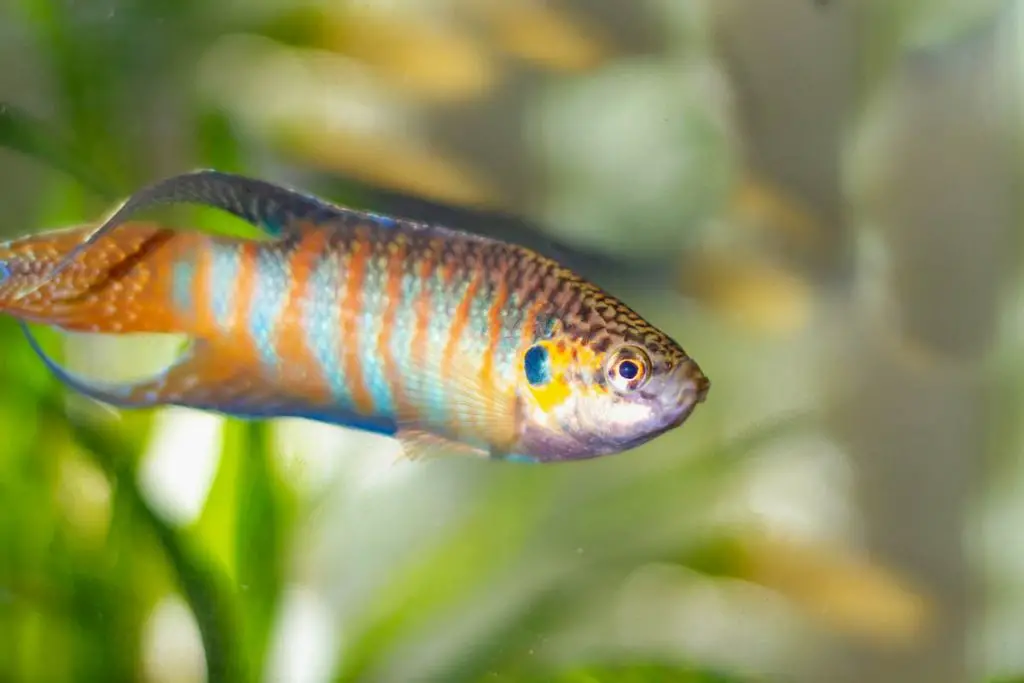
The natural habitat of the paradise fish is quite wide. It can be found all across southeast Asia. For example, in China, the fish can be found east of the Yangtze River basin to the Peal River Basin. The fish can be found in other countries such as Hong Kong, Taiwan, Vietnam, Malaysia, Japan, and Korea.
This fish has been introduced to areas it is not native and has taken to the new waters successfully. The United States and Madagascar have waters that can sustain the fish in the wild.
There are three species of tropical fish that are collectively known as paradise fish that is also known to be a common feature of home fish tanks. All three of these fish species look similar to each other but can easily be distinguished by their tails. Macropodus cupanus has a pointed tail that has extensions, Macropodus opercularis has a forked tail, and Macropodus Chinensis has a rounded tail.
All three of these fish species have stripes of color that look different depending on the angle of light. Typically, these bands will be primarily blue or green with stripes of orange or red. It is common to see numerous small dots of blue or black be scattered all over the fish’s body.
The paradise fish is known for being an aggressive fish. They are known to fight one another and will be more combative towards their species than other fish.
Types Of Paradise Fish
Paradise Fish come in several different color morphs, however, most are not named. The typical paradise fish tend to be blue and orange (sometimes red) striped with a tail that can be a variety of colors.
The Blue Paradise is colored blue and has less pattern. This species of Paradise Fish was created through breeding.
Albino Paradise Fish has a color mutation where they have some blue and red on their fins but their body is white and they have red eyes.
The Chinese Paradise Fish is a related species of fish that is often sold as being “round tail”. They normally do not have color morphs and are known to be picky about their diet.
The Black Paradise Fish is a fish species that is noted for its color and has a spiked tail. This species is more difficult to find and, in most cases, must be specially ordered.
Optimal Water Conditions for Paradise Fish
| Water Temperature: | 61 to 79 F |
| Water Flow Rate: | Low flow – they hate currents! |
| pH: | 5.8 to 8.0 |
| Water Hardness: | 5 to 30 dGH |
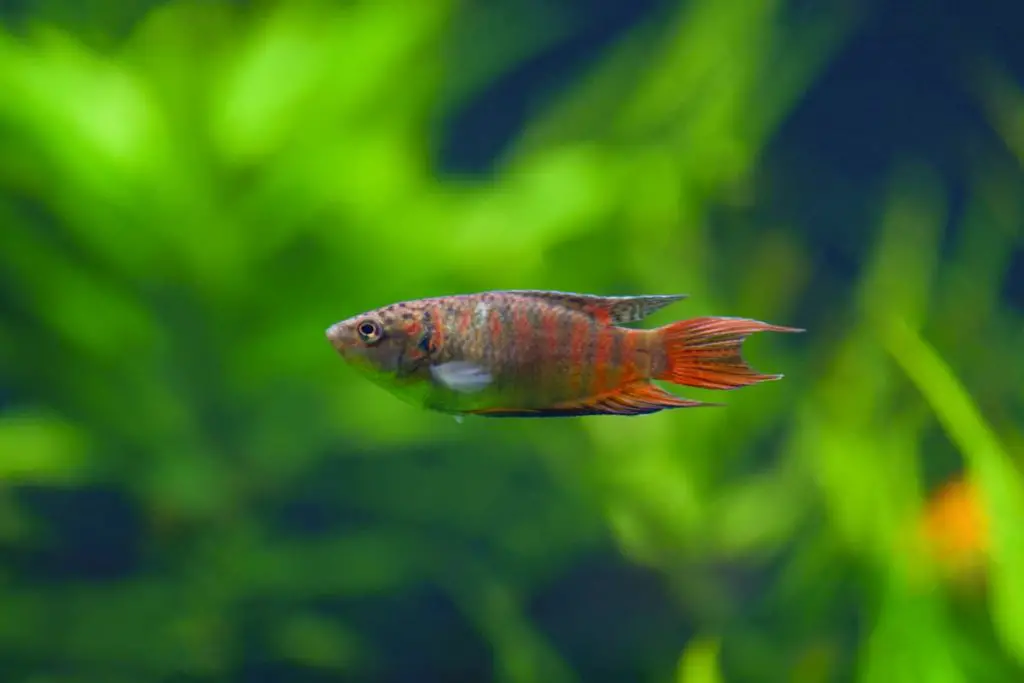
Tank Setup
| Minimum Tank Size: | 20 gallon |
| Optimal Tank Size: | 30 gallons per paradise fish. |
| Optimal Tank Shape: | Standard rectangular shape. |
| Recommended Filter Type: | Any standard filter is fine. |
The Paradise Fish is known for being resilient and capable of adapting to practically any water condition. However, this does not mean you should be negligent in keeping the water quality high and the water temperature stable. As is the case with most species, keeping consistent water parameters steady is best for these fish. This does mean that this fish is good for those who are new to fishkeeping and are uncertain about getting fish that are highly sensitive.
The size of an aquarium for a juvenile should be at least twenty gallons. As they mature you will need to ensure that you have at least twenty gallons per paradise fish. This should provide enough space for the fish to swim freely while still having plants, decorations, and filters.
Keep in mind that if you are housing multiple paradise fish together then you should increase the minimum to 30 gallons, the extra room will help ensure they fight less.
The water temperature of the tank can range from 68°F to 82°F. The key is to keep the water temperature consistent for the fish. The water pH should range between 5.8-8. The water hardness should be 5-30 dGH.
Creating the Landscape
When establishing the habitat for your Paradise Fish, it is important to try and recreate elements of their natural environment. This fish originates from freshwater shallows that contain a lot of picking the right plants is the key to a good foundation for your tank. The plants act as a place for your fish to hide when they are stressed, if the fish does not have a place to hide, they will die from stress.
Popular choices for plants in your aquarium include Java Moss, Hornwort, and Dwarf Hairgrass.
Due to how skittish this fish can be, having floating plants long with light dimmers can help the fish.
Driftwood, branches, root structures, and dried leaves can help give the tank a more natural feel and provide more places for the fish to hide.
When picking the substrate for the tank, it is important to pick a soft substrate. Paradise Fish do not spend a lot of time at the tank bottom, but they need soft soil.
| Best Plants: | Java Moss, Hornwort, Salvinia, Water wisteria, Guppy Grass, Duckweed, Dwarf Hairgrass |
| Best Lighting: | The tank should be at a normal level of brightness during the day. |
| Best Decorations: | Plants, smooth rocks, premade decorations without jagged edges. |
| Decorations to Avoid: | Sharp rocks and decorations with jagged edges. |
Physiological Considerations for Paradise Fish
| Size: | 4 inches |
| Lifespan: | 6 to 8 years |
| Temperament: | Semi-aggressive |
| Preferred Tank Region: | All areas |
| Scale Thickness: | Normal scale thickness. |
| Gill Considerations: | In addition to gills this fish has an organ that allows it to breath air like a lung. |
| Swim bladder Considerations: | No swim bladder concerns. |
| Fin Shape Considerations: | Due to the Paradise Fish having long fins it is important to decorate with only items they will not snag their fins. |
The average lifespan of a paradise fish is between eight and nine years. This assumes that the fish keeper gives good care and keeps the fish in an environment free from stress and a need to fight. There have been some instances of this fish living to be over ten years old, but this is uncommon and should not be expected even with the best possible care.
This fish is most notable for its captivating looks. They are known for having a classic “gourami” body that includes having a pointed head and a torpedo-shaped body. In addition to the colorful patterns, they have long fins that flow when they swim, adding to their elegant look. The dorsal and anal fins parallel one another and flow back.
The most common color you will find this fish in is blue with a reddish-orange color that fades near the top of their spotted head. The fish also has alternating blue and orange stripes that run vertically along the fish’s side. Their anal and dorsal fins are mostly blue with light stripes of orange and their caudal fin is orange with white edging.
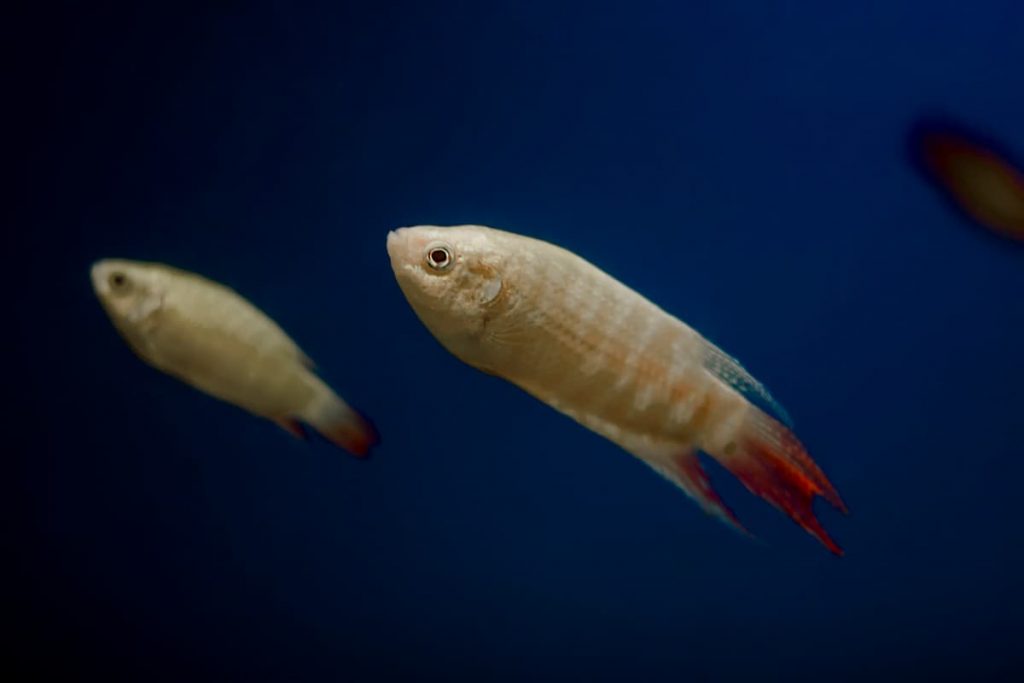
Society
In a community tank, paradise fish need to be the dominant species for the best compatibility. It should not be kept with other fish that may pose a challenge or attempt to fight for dominance. The fish will first try to fight any larger or aggressive fish and if they cannot drive the fish away then the paradise fish will hide and oftentimes literally die from stress.
While young, paradise fish can be kept in groups. However, as the males mature they will start to fight any other males and try to kill smaller males. The only way a group of mature males can stay in the same tank is if it is a very large tank that has plenty of décor for hiding and retreat for when they do fight.
Keeping a mix of neutral personalized fish that have different body shapes is the ideal mix for a tank. It is important to pay attention to the fish you pick and to make sure that if there are any confrontations between the fish in the tank, to move them as needed.
Larger fish that make good tankmates include goldfish and non-aggressive medium-sized fish like loricariid catfish, cyprinid, and geophages cichlids.
Some possible tank mates include:
- Goldfish
- Bala sharks
- Medium to large gouramis
- Bristlenose plecos
- Loaches
- Robust Cyprinid
- Large Characins
- Synodontis catfish
- Gian danios
- Loricariid Catfish
Gender, Breeding, and Reproductive Considerations
The male paradise fish is larger than the female and has color patterns that are brighter and stronger than those of the female fish. All three of the species of paradise fish have bands of colored stripes. During courtship, the male’s stripes are intensified due to hormones.
This fish species is not difficult to breed. In preparation for breeding, it is important to feed the fish live food as well as high-quality algae-based pellet or flakes and keep them in a separate breeding tank. It is especially important to feed the female in advance of trying to spawn her because she will refuse food for up to two weeks while holding eggs.
Leading up to mating, the male and female of the species need to be kept in separate tanks and fed small amounts of both life and frozen food several times a day.
After being well fed the female should begin to fill out and be plump from eggs. Any female not ready to mate should be kept away from any males ready for mating. The males have a terrible temperament and have been known to attack and sometimes kill intended females.
This species of fish is a bubble nest builder. The male builds, woo a female, they met and the female lays eggs in the nest.
Nutritional Needs
Paradise fish are omnivores that are happy to eat almost any type of food. However, to stay in good health, these fish must be given a well-balanced diet.
When in the wild, this fish will eat small fish and aquatic invertebrates. If this fish is in a pond, then it will eat mosquito larvae and any vegetable matter in the water.
While kept in an indoor aquarium, they should be fed generously once or twice a day. The basis for their diet should be a good algae-based flake along with meaty foods. A good choice is small live food such as brine shrimp or blood and white worms. In the wild, they get a lot of protein from various insects, so it is important to include live feeding. Live food provides them a lot more nutrition than any other kind of food.
Paradise fish are like bettas in that they will beg for extra food and would be content to eat until they die. It is important to make sure you are only feeding the fish enough to fulfill their dietary needs.
Infusoria is the ideal food for paradise fish fry.
Foods to consider feeding your fishy pals:
- Golden pearls
- Floating pellets
- Freeze dried tubifex
- Freeze dried blackworms
- Frozen (or freeze dried) bloodworms
- Frozen (or freeze dried) mysis shrimp
| Best Sustenance Food Type: | High grade (low-grain) pellets |
| Additional Food for Optimal Health: | Live invertebrates |
| Special Foods and Considerations for Best Color and Growth: | N/A |
| When and How Often to Feed Fish Based on Life Cycle: | Once or twice a day. |
Common Diseases and How to Avoid and Treat Them
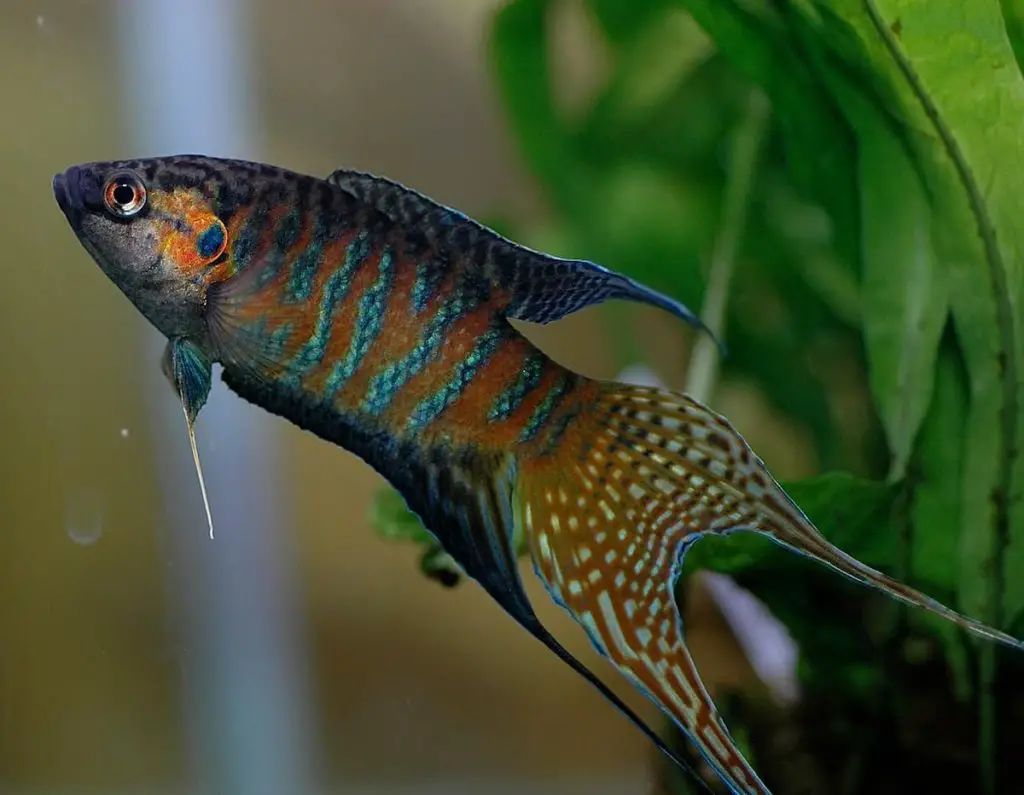
Paradise fish are not prone to any species-specific disease. The only precautions needed are for preventing common fish diseases such as ich and infections.
The best way to prevent your paradise fish from becoming sick is to keep the water quality at high levels. Dirty water is known to increase the likelihood that the fish will become sick, so quality water should always remain a priority. It is most cost-effective and takes less time to keep the tank water in good condition than it is to try and treat your fish once they become sick. Ultimately avoiding the illness will also ensure your fish has less suffering due to being sick.
This is a hardy fish species that existed long before modern fish-keeping methods. However, there are a few different fish illnesses to look for:
Lymphocystis (also known as LCDV) is an iridovirus. This virus causes tiny white spots, warts, and lesions. The virus is made worse when the fish is under stress. If this virus can progress it will cause the fish to have skin decay and open lesions. LCDV can be treated with a medicine purchased at a pet store along with making sure the water is frequently changed.
Costia is a parasite that is more common in cold-water fish but any fish in cold enough water can get it. It is caused by a parasite and it is difficult to detect in the beginning stages. It Is often not caught until it is advanced and requires aggressive treatment because of how long your fish has been suffering. When the disease has progressed far enough to be seen it shows up at grey or white-colored patches on the fish’s skin. Costia can be treated by purchasing over-the-counter medication and making sure the tank water is changed and kept clean.
Bloat can be caused by the accumulation of fluids, gas, or any unpassed food in the fish. The way to tell this between a fish who has overeaten is that the fish who ate too much food will still behave normally as the other fish can’t. The most noticeable symptom is the fish having a distended stomach but does not have raised scales. The treatment for bloat involves antibiotics and frequent water changes.
| Best Antibiotics: | Over-the-count antibiotics |
| Treatments to Avoid: | N/A |
| Food Recommendations When Sick: | Fresh and live foods |
| Hospital Tank or Isolation Withing the Community Tank: | You should isolate sick fish in hospital tanks to prevent the spreading of disease. |
1-7 Facts About Paradise Fish
- The paradise fish, along with the common goldfish, is the oldest species of domesticated fish. Samuel Pepps wrote in 1665 about how the Chinese would keep paradise fish in aquariums.
- The paradise fish is known as a labyrinth fish, this means it has an organ (labyrinth organ) similar to a lung that allows it to breathe air.
- The female member of the fish is smaller than the males and has less vivid colors.
- This species is known as the “true” paradise fish as other fish are called this.
- There are several types of paradise fish, including albino and a vibrant power-blue variety.
- The male paradise fish tends to violently fight other anabantid fish species. They should never be kept with gourami and betta fish. They have also known to be aggressive towards long-finned fish like angelfish.
- The adolescent paradise fish will start to show gender difference once they reach 2 to 4 months of age.
